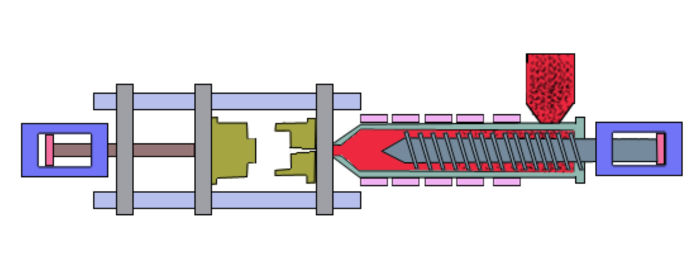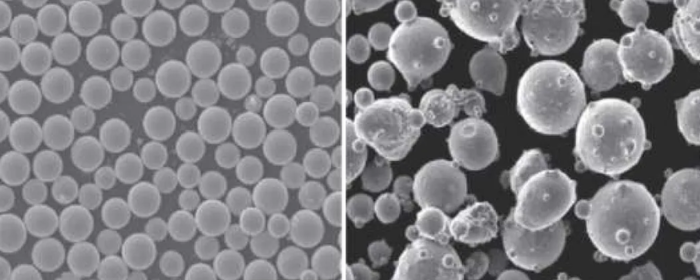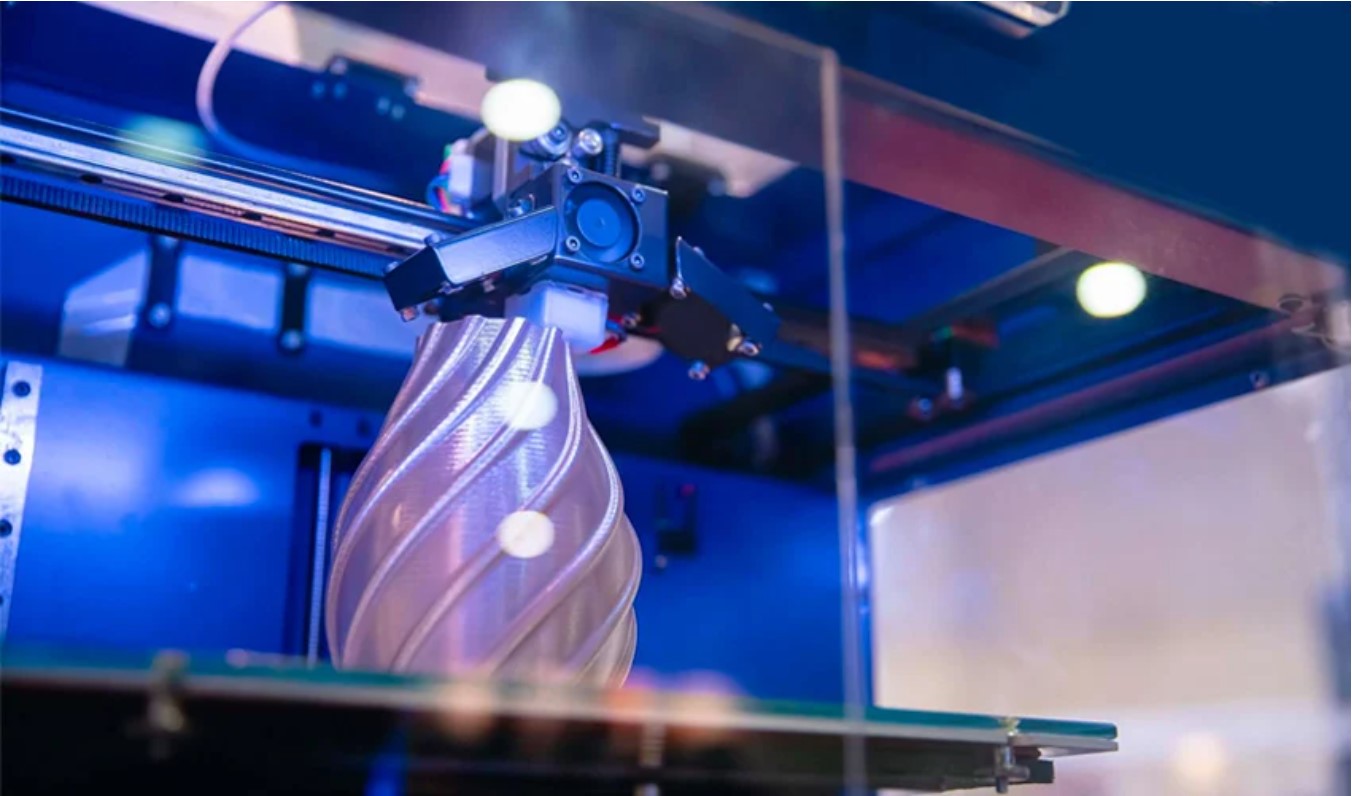

Tungsten Heavy Alloy (THA) Powder is an important high-performance engineering material. It’s composed of tungsten and other metals such as nickel, iron, and copper. This alloy powder possesses excellent mechanical, physical, and chemical properties, making it popular in aerospace, electronics, chemical, and other fields.
Take WNiFe powder as an example:
Tungsten-nickel-iron powder (WNiFe) is a high-density tungsten alloy powder consisting of tungsten (W), nickel (Ni), and iron (Fe). It combines the superior density and strength of tungsten with the additional advantages of nickel and iron. This powder is widely used in various applications:
.png)
Fig 1. Tungsten-nickel-iron powder (WNiFe)
The primary raw materials for tungsten heavy alloy powder include tungsten, nickel, iron, and copper. Each of these materials has unique characteristics:
Tungsten (W):
Tungsten is the base metal of tungsten heavy alloy powder. And it can enhance the density and strength of the alloy. This metal is extremely hard and has excellent wear resistance. It also has the highest melting point of all metals.
Nickel (Ni):
Nickel can improve the toughness and corrosion resistance of tungsten alloy. In addition, it also has good ductility and can enhance the machinability of the material.
Iron (Fe):
Iron can increase the strength of the alloy and has good machinability. It is also a common magnetic material. Because iron is cheap, using iron in tungsten high-density alloys can reduce costs.
Copper (Cu):
Copper has excellent electrical and thermal conductivity, second only to silver. It is resistant to environmental corrosion and is easy to process and form.
Cobalt (Co):
Cobalt can increase the hardness and wear resistance of the alloy. It also enhances oxidation resistance and high-temperature strength.
Molybdenum (Mo):
Adding molybdenum to the alloy can improve its high-temperature performance and corrosion resistance.
These raw materials are mixed, pressed, and sintered through powder metallurgy processes to form tungsten-heavy alloys with high density, high strength, and excellent physical and chemical properties. The ratios of these materials can be adjusted according to different application needs to optimize the performance of tungsten-heavy alloys.

Fig 2. Mechanical properties of tungsten heavy alloy of W-Ni-Fe with added molybdenum[1]
1. Tungsten content has the most significant effect on the density of high-density tungsten alloy powder. Because of its very high density, increasing tungsten content will directly increase the density of the alloy powder. Generally, the higher the tungsten content, the greater the density of the alloy. However, excessive tungsten content can reduce the plasticity and toughness of the alloy, affecting its machinability. Therefore, adjustments need to be made according to specific requirements in actual production.
2. Nickel content has a smaller effect on the density of high-density tungsten alloy powder. Although nickel's density is lower than tungsten's, its content in high-density tungsten alloys is usually low, mainly to improve the alloy's mechanical properties and corrosion resistance. Therefore, increasing nickel content does not significantly impact the alloy's density.
3. The content of other metals also has a minor effect on the density of high-density tungsten alloys. Iron's density is lower than tungsten and nickel, so its content has little impact on the density. Molybdenum's density is also lower than tungsten, but its content in high-density tungsten alloys is usually low, mainly to enhance the alloy's hardness and strength.
1. Tungsten content has the most significant effect on the strength of high-density tungsten alloy powder. Tungsten's high density and melting point give the alloy excellent strength and hardness. Increasing tungsten content typically significantly improves the strength of the alloy. However, excessive tungsten content can reduce the alloy's plasticity and toughness, affecting its suitability for some applications. Therefore, a balance between strength and toughness must be found in actual production, adjusting according to specific requirements.
2. Nickel content has a significant effect on the strength of high-density tungsten alloy powder. Adding nickel can significantly improve the ductility and toughness of the alloy, as well as its fatigue resistance. This is because nickel can form a ductile phase in the alloy, reducing the likelihood of crack propagation. Increasing nickel content helps maintain high strength while improving the alloy's toughness, making it perform better in high-stress and high-impact environments.
3. The content of other metals has a smaller effect on the strength of high-density tungsten alloys but should not be overlooked. Adding iron can further increase the strength and hardness of the alloy, especially in applications requiring high strength and magnetic properties. However, too much iron may reduce the alloy's toughness. Adding molybdenum can significantly enhance the alloy's high-temperature strength and hardness, allowing it to maintain good mechanical properties in high-temperature environments. Adding cobalt can also enhance the alloy's strength and wear resistance, making it suitable for applications requiring high hardness and wear resistance.
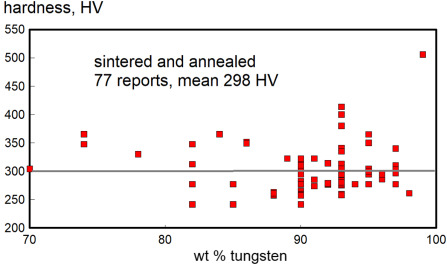
Fig 3. Hardness for sintered-annealed WHA compositions as a function of the tungsten content.[2]
1. Tungsten content has the most significant effect on the tensile properties of high-density tungsten alloy powder. Increasing tungsten content significantly improves the alloy's strength but also reduces its ductility. High-tungsten alloys usually exhibit high tensile strength but low elongation at break, meaning the material is more likely to fracture under tensile stress. To improve tensile properties while maintaining high strength, other metals are often added to enhance the alloy's ductility.
2. Nickel content has a significant effect on the tensile properties of high-density tungsten alloy powder. Adding nickel can significantly improve the ductility and toughness of the alloy, increasing its elongation at break. Nickel forms a ductile solid solution phase in the alloy, allowing it to absorb more deformation energy during tensile stress and slow crack propagation. Increasing nickel content typically enhances the tensile properties, making the alloy more suitable for high-tensile-stress conditions.
3. The content of other metals also significantly affects the tensile properties of high-density tungsten alloys. Adding iron can increase the tensile strength, but excessive iron may reduce the alloy's plasticity. Adding copper helps improve the alloy's electrical conductivity and ductility, enhancing its deformation capability during tensile stress. Adding molybdenum and cobalt can further enhance the high-temperature performance and wear resistance of the alloy, maintaining good mechanical properties under high-temperature tensile conditions.
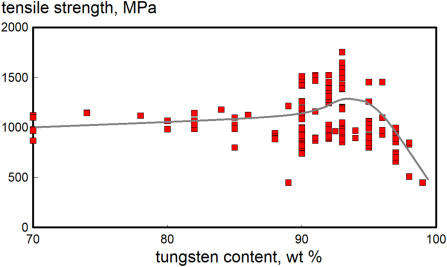
Fig 4. Scatter plot of ultimate tensile strength versus tungsten content[3]
Different raw material ratios will significantly affect the density, strength, ductility, and other properties. Therefore, when choosing tungsten heavy alloy powder with different raw material ratios, it is essential to consider the performance requirements of the application. Table 1. shows the differences in composition, performance, and application of THA powders with different raw material ratios, which can be used as a reference for purchasing THA powders.
Table 1. Selection Guide for Tungsten Heavy Alloy Powder with different material ratios
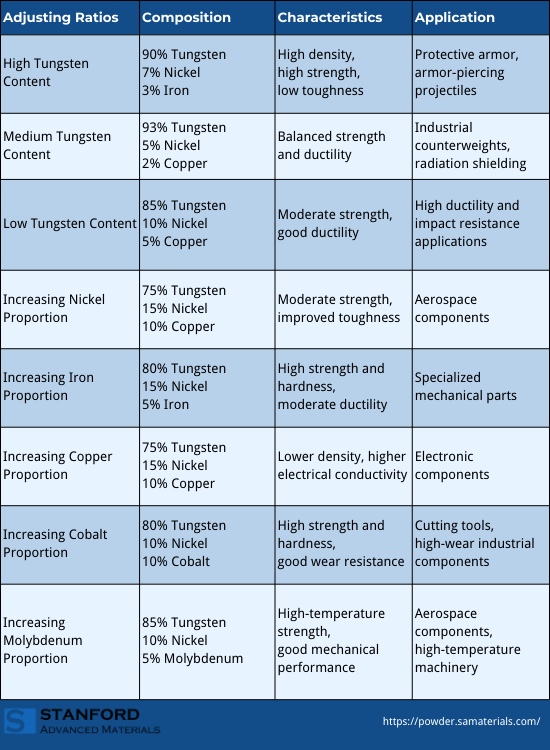
Stanford Advanced Materials (SAM) is at the forefront of powder development, offering Tungsten Heavy Alloy Powder such as Spherical Tungsten Nickel Iron Powder (WNiFe). There are also various Tungsten Alloy Powders such as W-3.5Ni-1.5Cu, W-6Ni-4Cu, Ta2.5W... For more information about these powders, please contact us and check out our page.
Adjusting the ratios of materials in tungsten heavy alloy powder significantly affects its density, strength, and tensile properties. A higher tungsten content generally increases density and strength but may reduce ductility. Nickel and other metals can be added to improve ductility, toughness, and overall performance, balancing the mechanical properties to meet specific application requirements. Thus, optimizing the material composition is crucial in tailoring tungsten heavy alloy powders for diverse and demanding industrial applications.
[1] Natarajan, Senthilnathan & Venkatachalam, Gopalan & A., Raja Annamalai & Jen, Chun-Ping. (2021). Effect of Rare Earth Metals (Y, La) and Refractory Metals (Mo, Ta, Re) to Improve the Mechanical Properties of W–Ni–Fe Alloy—A Review. Materials. 14. 1660. 10.3390/ma14071660.
[2] Randall M. German, Sintered tungsten heavy alloys: Review of microstructure, strength, densification, and distortion, International Journal of Refractory Metals and Hard Materials, Volume 108, 2022,105940, ISSN 0263-4368, https://doi.org/10.1016/j.ijrmhm.2022.105940.
[3] Randall M. German, Sintered tungsten heavy alloys: Review of microstructure, strength, densification, and distortion, International Journal of Refractory Metals and Hard Materials, Volume 108, 2022,105940, ISSN 0263-4368, https://doi.org/10.1016/j.ijrmhm.2022.105940.


